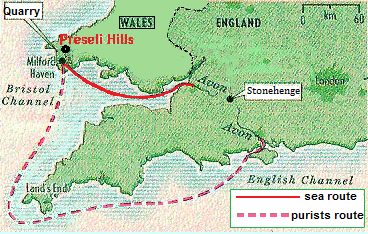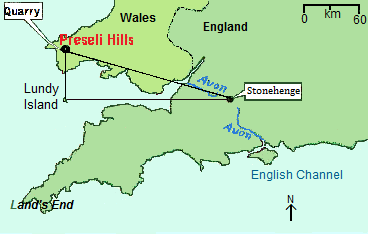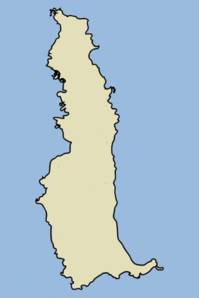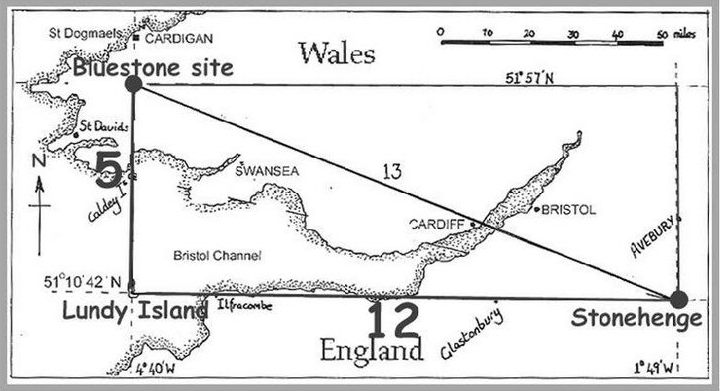| View previous topic :: View next topic |
Tilo Rebar

In: Sussex
|
|
 |
|
Corr blimey, I find it gob-smacking that after ~5000y we're still using the same symbol for a nodes on a transport hub as megalithic man did...

A good example of 'What is is what was'...
|
|
 |
|
 |
|
Mick Harper
Site Admin

In: London
|
|
 |
|
MegaBritain Part Twenty-One
The first thing to say is that they don't have very much to say. Historians, archaeologists and other interested parties treat the whole business of travel in Ancient Britain with remarkable insouciance. There are no specialists on this topic. Which is not surprising because, strictly speaking, there is no evidence and when there is no evidence .... nothing can be said.
If really pressed, the academics would of course have to concede that long distance travel must have taken place because of the indirect evidence -- of objects being found hundreds of miles from their origin -- so they have sort of cobbled together an account that composites three distinct methodologies:
1. Trade is carried out either randomly and/or fortuitously. This curious belief stems from anthropological studies of the way certain fairly primitive tribes exchange gifts (you will have heard of potlatch ceremonies) and thereby, it is argued, certain strategic items get exchanged over long distances. There is also somewhere in there the beguiling image of the peddlar acting as a kind of mini-tramp steamer.
2. It is a question of memory. This theory is derived partly from song-lines used by certain cultures to fix travel routes and (in Britain) drovers routes whereby people travel along immemorial tracks passed down the generations.
3. Certain natural lateral markers are used as guides, notably rivers and ridgeways.
It is true that an amalgam of these methods might just about meet the needs of the economic activity of Palaeolithic Britain. And even if it can't the professionals would simply adjust the economic activity of Palaeolithic Britain downwards to account for the paucity of evidence of long distance travel. This is how evidence-based subjects tend to proceed when the evidence is too insubstantial for an evidence-based approach. You use circularity to engender a self-evident 'truth'.
But the whole argument collapses when we reach the reasonably sophisticated economy (as all agree) of Bronze Age Britain, c 3000 BC, when not merely salt, textiles and flint axes are to be transported but copper and tin have to be mined at X and at Y and brought together regularly at Z in order to provide bronze implements for consumption at A, B, C ..... n.
The point is that the transport/navigation system shows no sign of changing at this time but this new trade is by its nature purposive. Copper and tin -- unlike salt, textiles and flint -- are completely useless on their own so neither is worth mining (formidable undertaking in their own right) unless you know where the other is available. And since we know that the X's and the Y's are hundreds of miles apart (Cornwall and North Wales) and that the A's, B's, C's ... n's are hundreds of miles away from either Cornwall or North Wales ... well, you'd have to be pretty lucky if a river or a ridgeway or a potlach ceremony or a song-line happened to be available for any one of these trips, never mind the infinite number now required.
|
|
 |
|
 |
|
Mick Harper
Site Admin

In: London
|
|
 |
|
MegaBritain Part Twenty-Two
But actually the dilemma was just as acute in the Neolithic Age. The bluestone sarsens at Stonehenge were mined at quarries in the Preseli Hills in south-west Wales. So it was only a matter of time until some enthusiastic archaeological re-enactors decided it would be a grand idea to replicate the journey, taking a large block of stone from Preseli to Stonehenge using only what was thought to be available in Neolithic times.
Great fun was had by all moving the three tonne monolith across land from Preseli to Milford Haven and loading it into a fairly primitive boat. The experiment ended when the ship capsized and the stone is now at the bottom of Milford Haven harbour. However, as usual with these reconstructions, the main point was entirely missed. It is not the actual transportation methods that is at issue -- anything can be moved any distance as long as sufficient manpower (and a modicum of ingenuity) is available -- it's the navigational part of the equation that is the abiding mystery. It doesn't matter how many there are of you and how ingenious you might be if you don't know where you're going.
So now put yourself in command of the new bluestone project Preseli to Stonehenge, but this time try to remember you are living in a non-literate age. Presumably you know, or you can find out from locals, how to get a stone from Preseli to Milford Haven, and once the stone is (this time) safely esconced aboard ship, the captain of said ship says to you, "Where to, guv'nor?"
To which you reply, "Um, it's a bit hard to describe but Stonehenge is over on the other side of the Bristol Channel, sort of up a bit, if you know what I mean."
"Well," says the captain, "I can cross the Bristol Channel right enough and I can sail up the coast alright but you will have to say when it's time to unload the stone for Stonehenge".

This stumps you but one of your fellow re-enactors chimes in with, "No, no, we can sail round Cornwall, up the English Channel till we get to the Avon, whereupon the stone can be transported up the river to the Stonehenge site".
"They're all called Avon in my experience," says the Captain, "But either way how are we going to know which river is the one we want? There are a great many between here and ... er ... there."
Fortunately, there are also a great many archaeologists around nowadays so it will be simplicity itself to arrange for one to be posted at the estuary of every river in south-west Britain waving out to sea, "Not this one." Except for the one that is waving, "It's this one." And no doubt there were lots of spare bods in Palaeolithic times too.
Of course the problem can be solved but it is passing strange that while there a hundreds of accounts of how to mine, move and erect sarsens, there is not a single line in the academic literature about the navigational side of things. Though oddly there is in the non-academic literature.
|
|
 |
|
 |
|
Wile E. Coyote
In: Arizona
|
|
 |
|
| Mick Harper wrote: | MegaBritain Part Twenty-Two
This stumps you but one of your fellow re-enactors chimes in with, "No, no, we can sail round Cornwall, up the English Channel till we get to the Avon, whereupon the stone can be transported up the river to the Stonehenge site".
|
"Did someone say haven?"
"I know we need to seek a safe haven to transport and unload these stones, the problem is recognising it"......
|
|
 |
|
 |
|
Boreades

In: finity and beyond
|
|
 |
|
| Mick Harper wrote: | | Of course the problem can be solved but it is passing strange that while there a hundreds of accounts of how to mine, move and erect sarsens, there is not a single line in the academic literature about the navigational side of things. Though oddly there is in the non-academic literature. |
These hundreds of accounts all make the same gross assumption, that megalithic folk only knew how to use bashing and brute force, to shape and move sarsen stones. Just as they assume the same about how the pyramids were made. In both cases, it's a lot less effort to make the stones in situ, from geopolymer concrete, as any sensible and competent civil engineer would do. After a few thousand years, a geopolymer sarsen, made from natural ingredients, will look the same as a natural stone.
|
|
 |
|
 |
|
Mick Harper
Site Admin

In: London
|
|
 |
|
| After a few thousand years, a geopolymer sarsen, made from natural ingredients, will look the same as a natural stone. |
A critical observation. What is your evidence? And would you have to use bluestone polymer to make it resemble a naturally quarried bluestone sarsen?
|
|
 |
|
 |
|
Tilo Rebar

In: Sussex
|
|
 |
|
| Mick Harper wrote: | | ...What is your evidence? |
Not an easy question to answer, as the 'Bluestone' at Stonehenge is not all of the same type...
" If the Sarsens and the Bluestones were carefully selected for use at Stonehenge, how come that there are at least 30 different rock types represented in the Stonehenge "Bluestone Assemblage"? (including fragments, orthostats, stumps, mauls and hammerstones)"
There are nine further questions which cast doubt on the validity of current theory about Stonehenge here...
http://brian-mountainman.blogspot.co.uk/2014/03/ten-bluestone-questions.html
|
|
 |
|
 |
|
Mick Harper
Site Admin

In: London
|
|
 |
|
MegaBritain Part Twenty-Three
And this brings us to a central difficulty that afflicts all prehistory. The academics constantly ignore various areas of their subject because of the lack of evidence. This lack of evidence -- or perhaps we should say their consequent lack of interest -- means that the academics assume that the Ancients weren't up to much ("Otherwise they would be producing evidence, wouldn't they"). This is a notable spin on their oft proclaimed dictum: "The absence of evidence is not evidence of absence." On the contrary, it very much is, as far as they are concerned.
As it happens, this overview is complete rubbish. The apparent lack of evidence merely reflects the academics a priori assumption that essentially everything begins with literacy so they simply adjust their definition of evidence when it comes to pre-literate times to make sure that there is ... um ... no evidence.
Into this artificially-induced vacuum, a whole horde of people -- we shall call them The Crazies -- have poured, finding vast amounts of 'evidence'. A lot of it, alas, crazy. This is because while the Crazies are just as intelligent as the academics and certainly spend comparable amounts of their time on their chosen subject, they lack the discipline of the university. With them, anything goes.
This allows the academics to ignore all their work. Worse, anything tainted by being associated with the Crazies automatically gets pushed to and usually beyond the margins of what is permitted to be taught, to be researched, to be believed by any academic looking for professional advancement.
Hence, while the professionals are willfully ignoring the very real problems of navigating between the Preseli Hills and Stonehenge, the Crazies have come up with an elegant solution. They have pointed out that you can form a perfect Pythagorean 5-12-13 triangle by joining the points Preseli Hills, Lundy Island and Stonehenge.

The fact that the Welsh term for Lundy Island is Ynys Elen, Elen (Elin) meaning 'elbow' or 'angle', would seem to indicate that this is neither an imaginary nor a fortuitous connection. It certainly is not because the outline of the island resembles an elbow, quite the contrary:

Nor is this triangle in any sense 'crazy'. It is a simple method of navigating from Preseli to Stonehenge because it requires no great feat of skill to follow a bearing of due south or of due east, so the journey can be undertaken with some confidence in the absence of charts, maps, signposts or people paddling about in estuaries shouting, "Move on! Nothing to see here!"
This is not to say that this is actually what happened but it is to ask why academics are so resistant to such apparently significant connections. Well, we shall see why.
|
|
 |
|
 |
|
Boreades

In: finity and beyond
|
|
 |
|
| Mick Harper wrote: | Nor is this triangle in any sense 'crazy'. It is a simple method of navigating from Preseli to Stonehenge because it requires no great feat of skill to follow a bearing of due south or of due east, so the journey can be undertaken with some confidence in the absence of charts, maps, signposts or people paddling about in estuaries shouting, "Move on! Nothing to see here!"
|
No great feat of skill?
Err, have you sailed in the Bristol Channel recently? For those that don't know, the Bristol Channel has one of the highest tidal ranges in the whole world. You might think you are sailing due east or west, but you won't be. The tide can be moving faster than your boat, in a different direction, and the direction changes by the hour. You will be very lucky if it's moving in the same direction as you want.
You will still need to regularly check your bearing, and change your course accordingly. You do have a compass, don't you? If you don't, do take your box of crows.
|
|
 |
|
 |
|
Mick Harper
Site Admin

In: London
|
|
 |
|
|
Yes, Boreades, but we are dealing with real sailors.
|
|
 |
|
 |
|
Mick Harper
Site Admin

In: London
|
|
 |
|
|
Tides? These people actually surf the tides.
|
|
 |
|
 |
|
Mick Harper
Site Admin

In: London
|
|
 |
|
Something has come up which is new to me (can people let me know if it wasn't new to them, as I am keen to know how and why this slipped throught my cracks). This is Robin Heath's map of the "Preseli triangle"

You will see that a) Glastonbury is on one side of the triangle (is there a name by the way for the second longest side of a right-triangle?) and b) Avebury is on the rectangle formed from the triangle. Those of you with the requisite equipment and no day-job might care to address yourself to two problems
a) are these two places at significant points along their respective lines and
b) how near are the two places actually to the line (as opposed to looking on the line on a small-scale map)?
|
|
 |
|
 |
|
Wile E. Coyote
In: Arizona
|
|
 |
|
Good ole Saint Piran (patron saint of tinners and miners) made it from Ireland to Cornwall on a millstone (maybe a giant stone was in his boat?).
His recollection might have been addled by age though, as he lived to 206.
CF....."Drunk as a perraner"........
|
|
 |
|
 |
|
Boreades

In: finity and beyond
|
|
 |
|
| Mick Harper wrote: | | Tides? These people actually surf the tides. |
With 30 tonnes of stone as cargo? To do that, you would need a ship that makes the Veneti vessels look puny. ROFL
|
|
 |
|
 |
|
Mick Harper
Site Admin

In: London
|
|
 |
|
|
You just show your ignorance yet again, Boreades. The bluestones were reduced to a powder in Preseli and re-constituted as sarsens at Stonehenge. The exact amount of powder for optimum surfing was placed aboard ship.
|
|
 |
|
 |
|
|